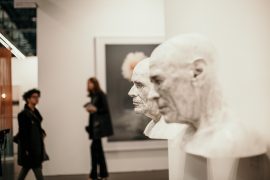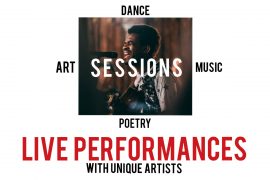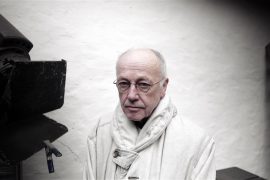Die Fotografie als neues Medium spielt seit ihrem Entstehen im 19. Jahrhundert eine entscheidende Rolle in der Entwicklung der Düsseldorfer Kunstszene und brachte ein intermediales Oszillieren mit sich, das nicht nur die Vielfalt der Künste innerhalb der Stadt seit jeher geprägt hat, sondern immer schon eine grenzüberschreitende Ausstrahlung hatte. Grundlagenarbeit haben Ilsabe und Gerolf Schülke mit ihrem 1994 vorgelegten Bericht Düsseldorf und seine Fotografie geleistet, den sie im Auftrag des Kulturdezernats Düsseldorf anfertigten.[1] Aus den in lokalen Archiven und Sammlungen gewonnenen Erkenntnissen stellen sie darin Fotograf:innen und die fotografischen Entwicklungen in Düsseldorf von 1840 bis 1940 als derart erstmalige Bestandsaufnahme und Übersicht zur Düsseldorfer Fotogeschichte vor. Auf Grundlage ihrer intensiven und vielfältigen Rechercheergebnisse geben sie den Impuls für ein in der Zukunft zu denkendes fotografisches Institut in Düsseldorf[2] und weisen auf das noch auszuschöpfende Potenzial hin, das die Fotografie in Düsseldorf noch immer in sich trägt. Auch die heute von Düsseldorf ausgehenden Dialoge und Diskurse sind Teil eines einzigartigen, sich immer weiterentwickelnden global verzweigten Interaktionsnetzes. Dabei nimmt das vielgestaltige Arbeiten mit der Fotografie eine zentrale Rolle ein.
>>Please scroll down for English version!<<
Die 1773 als Kurfürstlich Pfälzische Akademie der Maler-, Bildhauer- und Baukunst gegründete Kunstakademie Düsseldorf etablierte sich ab 1826 unter der Leitung von Friedrich Wilhelm von Schadow zu dem, was als Düsseldorfer Malerschule über Jahrzehnte hinweg weltweit Anerkennung finden sollte, denn Schadows Akademiereform bestand in der Förderung der Zusammenarbeit der Künstler[3] und Künste. Ein entscheidendes diskursbildendes Forum zum Ausstellen der Werke der Studierenden der Akademie wurde der Kunstverein für die Rheinlande und Westfalen, den Schadow 1829 mitbegründete.
In den 1850er Jahren galt die Düsseldorfer Kunstakademie nicht zuletzt durch den Maler Emanuel Leutze als liberaler Ort mit Schülern aus zahlreichen Nationen. Neben der Akademie bildete der 1848 durch Künstler[4] gegründete Malkastenverein eine interkulturelle Schnittstelle in der Düsseldorfer Kunstszene. So bündelten sich die künstlerischen Energien in Akademie, Kunstverein und Malkasten und fanden mit der Düsseldorf Gallery – einem von Johann Gottfried Böker begründeten Ausstellungsraum in New York, der zwischen 1849 bis 1862 Kunstwerke der Düsseldorfer Malerschule präsentierte – eine interkontinentale Brücke und transatlantische Ausweitung des Düsseldorfer Kunstmarkts. Insbesondere die Hinwendung zur Hudson River School[5] sollte zu einem anhaltend kollaborativen (Studien-)Austausch mit Düsseldorf führen. Ein Bindeglied zwischen Vertretern der Düsseldorfer Malerschule und der Hudson River School war die Vorstellung von unberührter Natur und die sogenannte „Tour of the Rhine“ zählte für viele amerikanische Maler selbstverständlich zur Grand Tour der 1850er Jahre dazu.
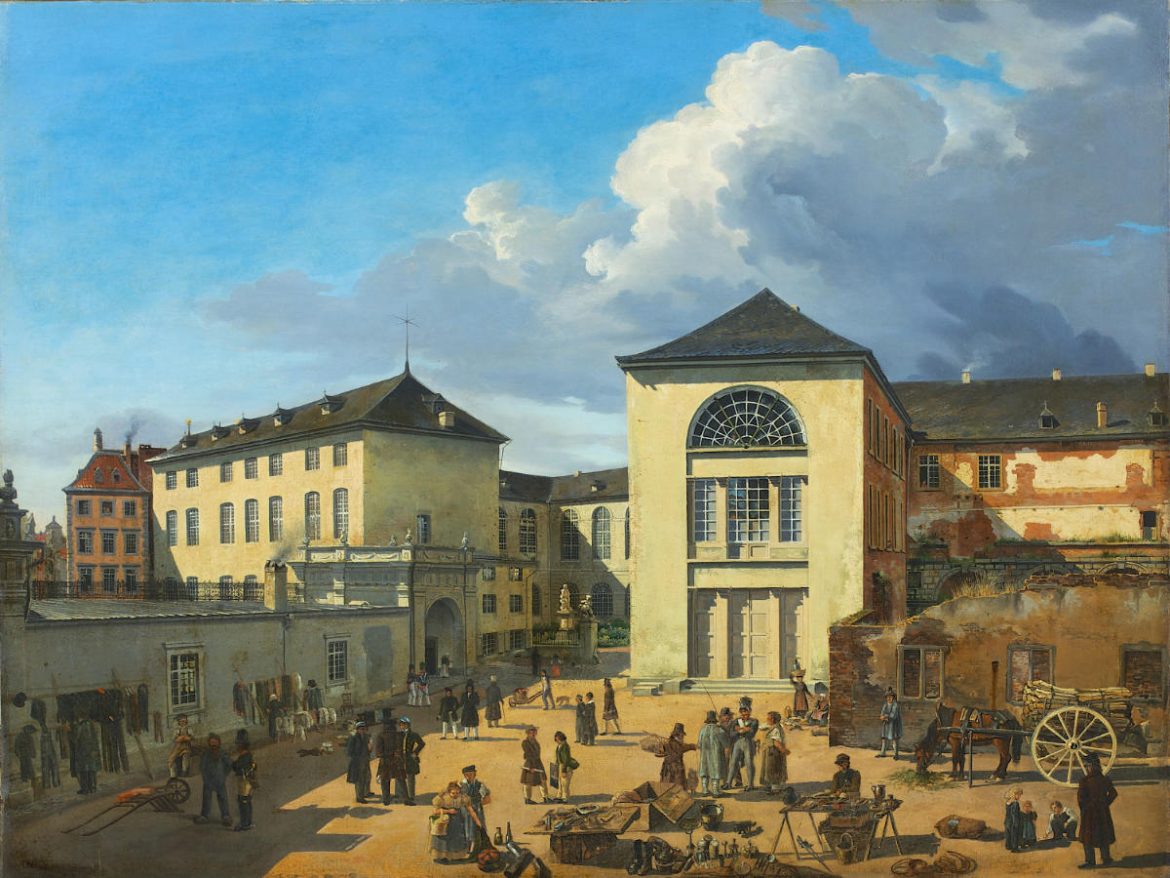
Eine entscheidende Weiterentwicklung für die Düsseldorfer Malerschule war in dieser Zeit auch die mit der aufkommenden Fotografie einhergehende neue Seherfahrung, die insbesondere in der Landschaftsmalerei Resonanz fand. Künstler wie Oswald Achenbach oder Johann Wilhelm Schirmer besaßen umfangreiche Fotoarchive[6], aus denen sie für die Komposition ihrer Malerei schöpften. Der amerikanische Maler Albert Bierstadt, dessen Brüder – die Bierstadt Brothers – Experten in stereoskopischer Fotografie sowie Landschafts- und Portraitfotografie waren, absolvierte von 1853 bis 1856 eine Malerausbildung an der Düsseldorfer Kunstakademie. Zweifelsohne hatte die Fotografie Einfluss auf die Düsseldorfer Maler, nicht nur auf Bierstadt – der nach seiner Rückkehr nach Amerika zu einem der führenden Landschaftsmaler in den USA wurde.
Es ist beachtenswert, dass die Fotografie als bildgebende Methode in Düsseldorf von Anfang an auch Teil künstlerischen Repertoires gewesen ist: Der Übergang vom fotografischen Medium als Vorlage für Kunstwerke bis hin zu der Autonomie der künstlerischen Fotografie im Kontext akademischer Lehre befand sich dann über etwa einhundert Jahre hinweg in einem Entwicklungsprozess, den es noch eingehend zu erforschen gilt.[7] Die damit einhergehende fotografische Diskursbildung jedoch ist nicht allein auf die Gründung der deutschlandweit ersten Klasse für künstlerische Fotografie 1976 durch Bernd [und Hilla] Becher an der Düsseldorfer Kunstakademie zurückzuführen.[8] 1962 etwa begann der damals an der Kunstakademie studierende Gerhard Richter mit der Arbeit an seinem sich über Jahrzehnte erstreckenden Projekt Atlas – einer Sammlung von Fotografien, Zeitungsausschnitten und Skizzen, die der Künstler kontinuierlich kompilierte und bis 2013 auf Bildtafeln zueinander in Beziehung setzte.
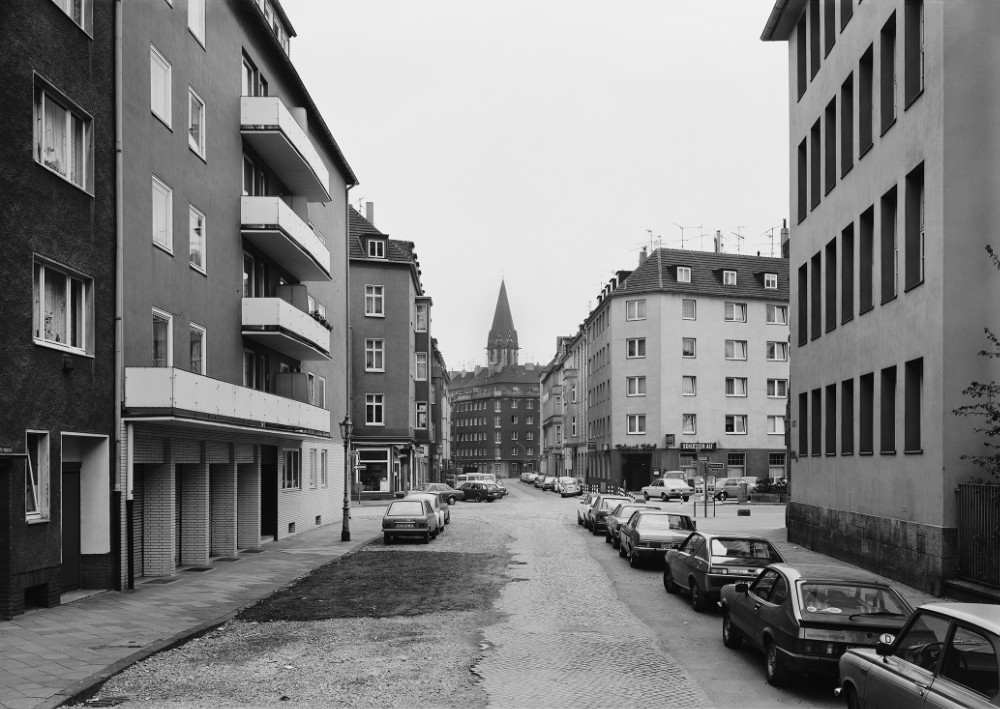

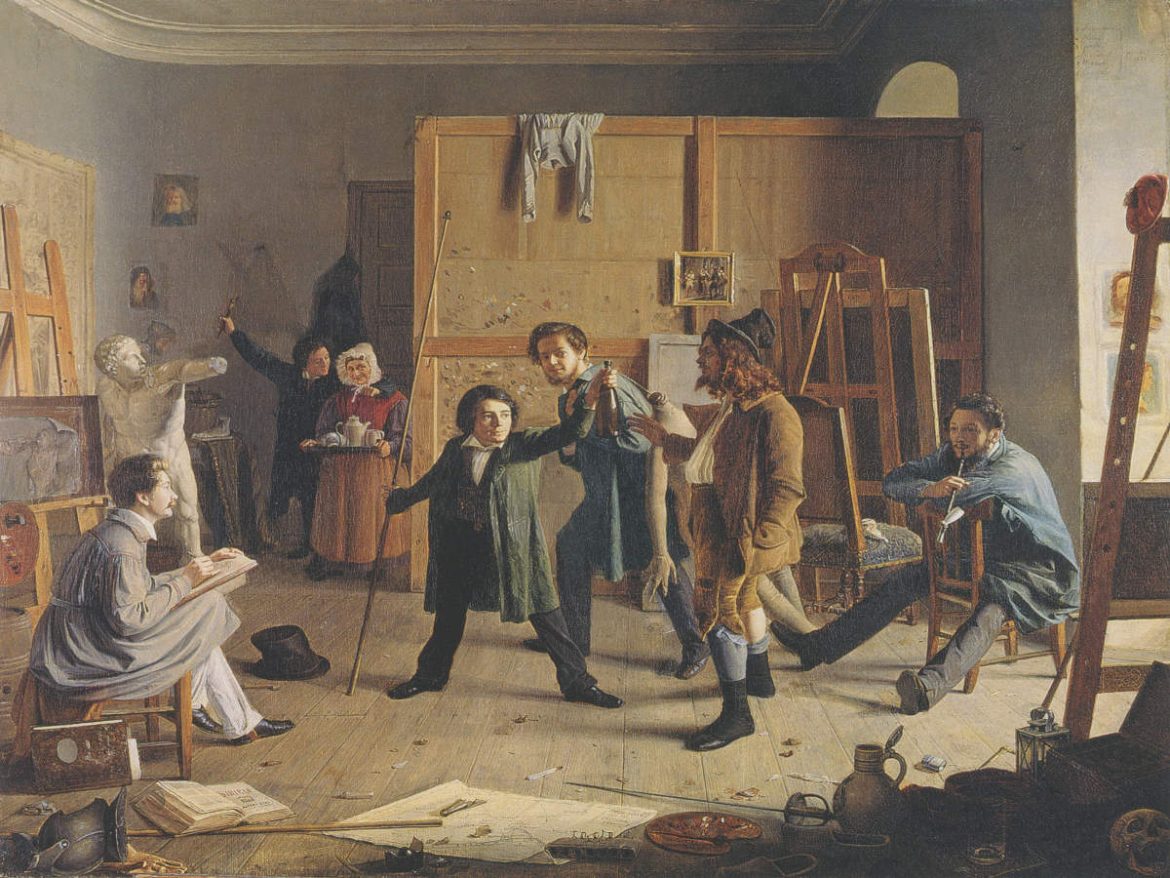

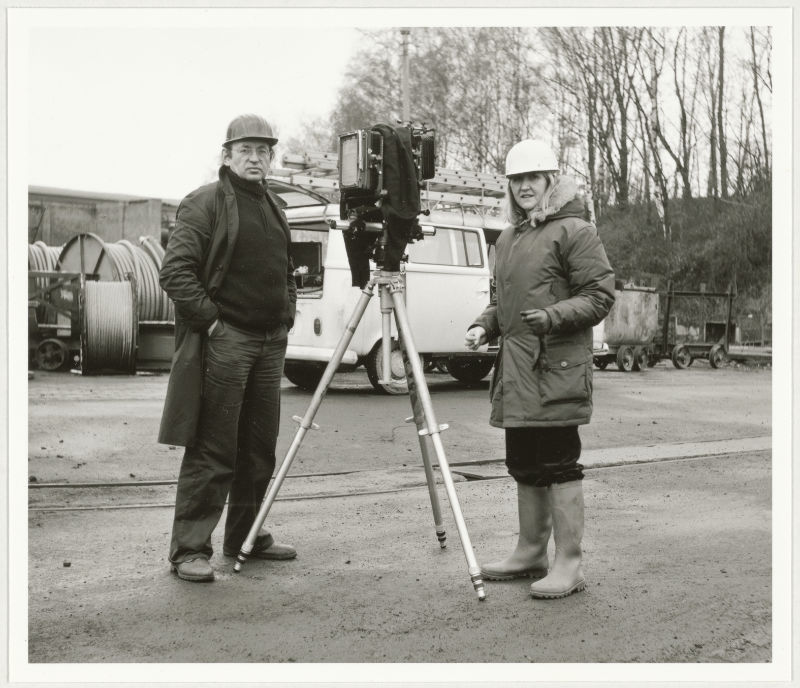
Entscheidende Impulse zur künstlerischen Autonomie der Fotografie und zur (kritischen) Fotografieforschung setzte die für Düsseldorfs Kunstszene nun erneut zunehmend an Bedeutung gewinnende Fotografin Erika Kiffl: Mit den von ihr 1980 bis 1989 auf Schloß Mickeln initiierten und durchgeführten internationalen Fotosymposien stieß sie wichtige Fragen zur Fotografie, zu fotografischen Verfahren und dem hiermit verbundenen künstlerischen Ausdruck an und brachte sie in einen Fachaustausch.[9] Zu den Teilnehmer:innen zählte 1981 der Kultur- und Kommunikationsphilosoph Vilém Flusser, der – geprägt durch die hier geführten Diskussionen – 1983 seine entscheidende Publikation Für eine Philosophie der Fotografie dank der Herausgabe von Andreas Müller-Pohle veröffentlichte.[10] Flussers Thesen zu Fotografie und Medien haben die künstlerisch-fotografische Produktion in Düsseldorf geprägt, so zum Beispiel die Arbeit des Medienkünstlers Mischa Kuball oder den Unterricht des kalifornischen Konzeptkünstlers und Fotografen Christopher Williams an der Düsseldorfer Kunstakademie.
Ähnlich wie Schadow und Leutze bereits im 18. Jahrhundert das Bild und das künstlerische Arbeiten im Plural dachten, initiierten ab den 1960er Jahren Fotograf:innen aus einem Konglomerat von Düsseldorfer Kunstakademie, der Werkkunstschule Krefeld (später Hochschule Niederrhein), sowie verstärkt auch in den vergangenen Jahren der HSD Hochschule Düsseldorf einen Diskurs über und mit dem Medium Fotografie, der Seltenheitswert besitzt. Denn diese Betrachtungen gingen oft aus von einem Blick auf das, was konkret da gewesen ist – und durch das Medium Fotografie zu einer spezifischen Form des Ausdrucks gefunden hat. Dies wurde etwa 2020 in der Ausstellung „Subjekt und Objekt. Foto Rhein Ruhr“ in der Kunsthalle Düsseldorf sichtbar. Über viele Jahre hinweg sind solche Entwicklungen durch die Autorin Helga Meister dokumentiert und aufgearbeitet worden.[11]

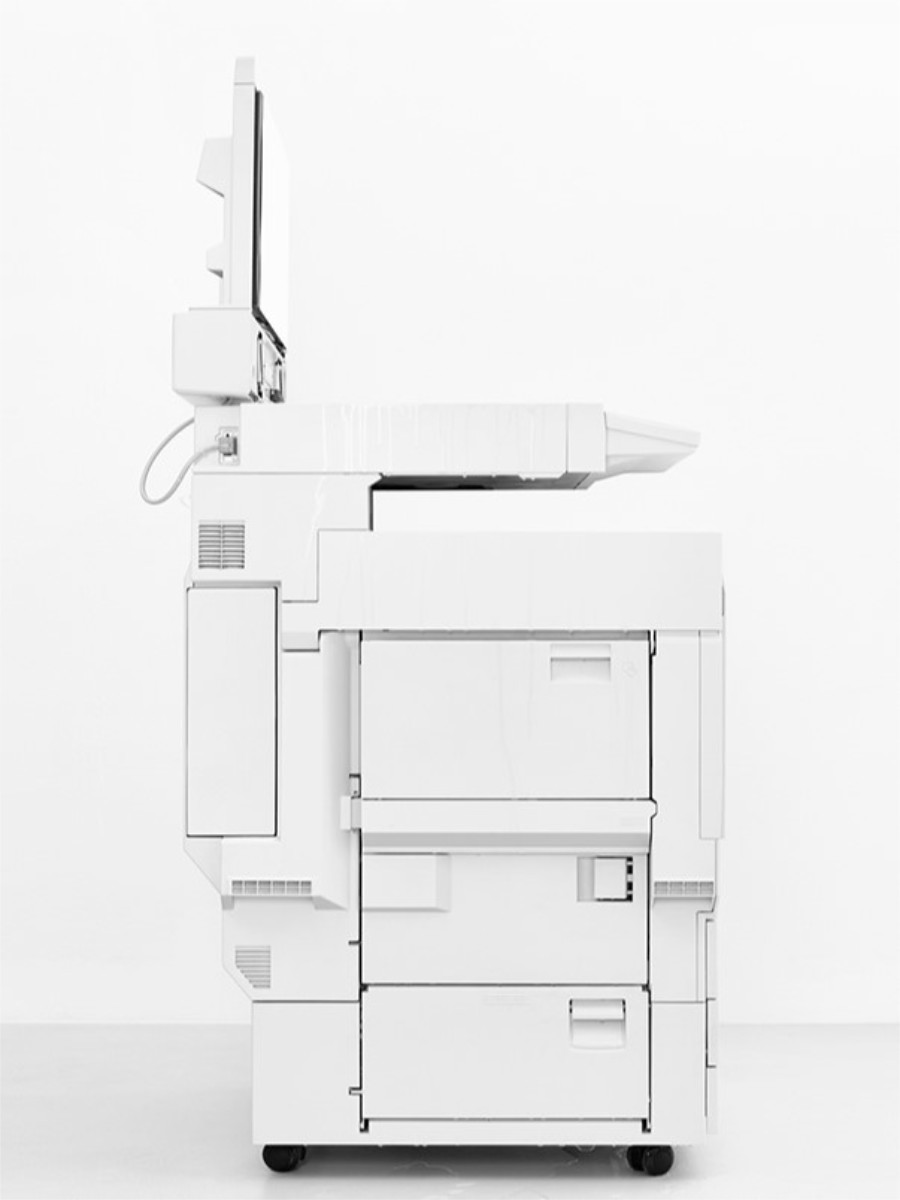

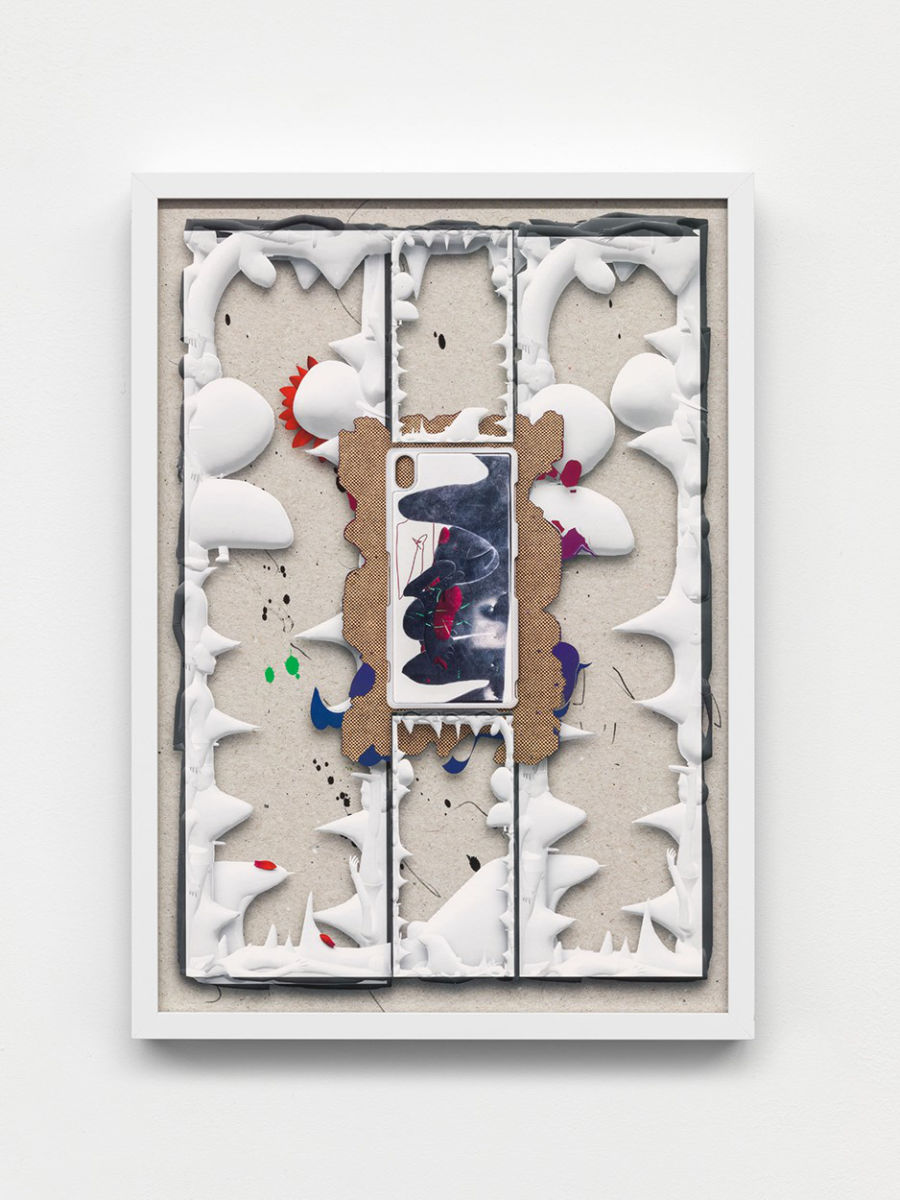
Es geht also auf eine lange Tradition zurück, dass die Düsseldorfer Kunstszene Impulse setzt, Netzwerke herausbildet und sich in einem globalen Austausch befindet. Nicht nur die Lehre und fotografische Ausbildung haben in Düsseldorf zu einer gelebten fotografischen Praxis und zu einem erweiterten Begriff von Fotografie geführt: Auch die produzierende Industrie trägt hier maßgeblich dazu bei, dass sich das Medium und dessen Gebrauch überhaupt derart hat entwickeln können. 1967 gründete der Fotograf F.C. Gundlach das fotografische Dienstleistungsunternehmen Creative Color (CC) in Hamburg und Düsseldorf. Die hieraus dann 1977 resultierende Galerie Creative Color Düsseldorf (CCD) zählt zu den ersten Galerien für Fotografie und steht als wichtiger Ort für die Spektren der Fotografie von angewandter Fotografie bis zur Kunst.[12] Die Fachlabore Grieger (mit Erfahrungswerten seit über 50 Jahren) und hsl (seit 1987) wiederum sind zu Hauptproduzierenden einer Bildsprache geworden, für die zahlreiche Künstler:innen in Düsseldorf durch ihre eigenen (Großformat-)Produktionsverfahren wie jene von Katharina Sieverding und Andreas Gursky wichtige Impulse gegeben haben. Die Expertise der Fachlabore hat auf entscheidende Weise die Fotografie mitgeprägt wenn nicht gar Facetten dieses Mediums überhaupt erst ermöglicht – zur Sichtbarkeit Gebrachtes, wie wir es heute in Ausstellungen weltweit erfahren. Auch sind auf Fotografie und optische Techniken spezialisierte Firmen wie die japanischen Unternehmen Canon, Eizo, Epson, Nikon, Fujifilm und Wacom mit ihrem deutschen bzw. europäischen Hauptsitz in Düsseldorf und Umgebung lokalisiert und haben über Jahrzehnte hinweg zu einer weiträumigen Marktentwicklung beigetragen.
In Düsseldorf hat sich in diesen Zusammenhängen nicht nur eine rasante Entwicklung des Mediums Fotografie vollzogen, die noch immer anhält – sie wird seit über vierzig Jahren von der Bewahrung von fotografischen Erzeugnissen begleitet. 1976 hat die Stadt Düsseldorf ein Restaurierungszentrum eingerichtet, das mittlerweile die Fotorestaurierung sowie Restaurierungs- und Konservierungsmaßnahmen für die vielfältige Düsseldorfer Museumslandschaft und deren Archivbestände einschließlich Nachlässen umfasst. Unter den etwa 3.5 Millionen betreuten Objekten befinden sich reiche fotografische Bestände, die von den weltweiten Anfängen der Fotografie bis in die Gegenwart reichen und eine große Bandbreite fotografischer Techniken abdecken.[13]
Düsseldorf vereint die Vielfalt des Fotografischen und so sind angewandte und künstlerische Fotografie hier seit jeher miteinander im Dialog – nicht zuletzt vor dem Hintergrund einer Landeshauptstadt, die jahrzehntelang als führende Mode- und Medienstadt galt und in der sich bis heute eine vielfältige und elektronisch geprägte Musikszene entwickelt. Eine entscheidende Rolle spiel(t)en in diesem Zusammenhang auch die (lokalen) Galerien. Peter Lindbergh etwa, den sehr früh schon die Galerie Hans Mayer ausgestellt hatte und dem der Kunstpalast Düsseldorf 2020 eine umfassende Retrospektive gewidmet hat, etablierte sich als einer der einflussreichsten Modefotografen der vergangenen vierzig Jahre. Mayer wiederum, in dessen Galerie am Grabbeplatz sich 1979 Andy Warhol und Joseph Beuys kennengelernt hatten und der die Medienkunst des Koreaners Nam June Paik in den 1980er und 1990er Jahren ausgestellt hatte, prägt Düsseldorf mit seinem genreübergreifenden Galerieprogramm zwischen (Medien-)Kunst, Mode und Musik seit über 50 Jahren. Ebenso die Konrad Fischer Galerie, die zu einer Zeit künstlerische und konzeptuelle Fotografie zu zeigen begann, als das Medium weder in der kuratorischen Praxis noch im Kunstmarkt etabliert war: Mit der ersten Galeriepräsentation der Arbeiten von Bernd und Hilla Becher ebneten die Fischers 1970 den Weg zur Karriere des Künstlerpaars und damit zu einer ganzen Folgegeneration an Fotograf:innen.[14]
Von den Anfängen des fotografisch basierten Malens an der Düsseldorfer Kunstakademie über die Etablierung des fotografischen Verfahrens als künstlerisches Medium und dessen Diskursbildung bis hin zu umfassenden Sammlungen zeitbasierter Medienkunst wie mit der Julia Stoschek Collection – die Fotografie in Düsseldorf ist eine sich über nunmehr Jahrhunderte hinweg entwickelnde Genese, die in den letzten Jahren durch Festivals wie Duesseldorf Photo Weekend und die Biennale düsseldorf photo+ in ihrer Diskursivität erweitert wurde. Diese Entwicklung basiert nicht allein auf dem Fortentwickeln einer bildschaffenden Technik, sondern auf den Menschen, die dieses Kunstsystem gemeinschaftlich auf Basis ihres Interesses und ihrer Expertise tragen. Vor diesem Hintergrund ist auch die bereits im Jahr 2009 ergriffene Initiative von Düsseldorfer Fotokünstler:innen zu sehen, auf der die Begründung eines Deutschen Fotoinstituts in Düsseldorf (DFI) basiert: mit dem Ziel, Fotografie aktiv durch das Medium selbst weiterzudenken sowie auf der Erfahrung mit und Haltung zu einem erweiterten Verständnis von Fotografie aufzubauen.
Dieser Text ist ein modifizierter Auszug aus dem Bericht Düsseldorf und die Fotografie, herausgegeben vom Kulturamt der Landeshauptstadt Düsseldorf. Autorin ist die Kunst- und Medienwissenschaftlerin Dr. Christina Irrgang. Konzept und Redaktion: Stefan Hostettler, Moritz Wegwerth, Verein zur Gründung und Förderung eines Deutschen Fotoinstituts e.V.; Stephan Macháč, Koordinierungsstelle Fotografie, Kulturamt der Landeshauptstadt Düsseldorf. Erschienen im Juni 2022, verfügbar unter: www.duesseldorf.de/fotografie.
Düsseldorf und Fotografie ist jetzt auch mit einem Account auf Instagram: @duesseldorfundfotografie.
Den ursprünglichen Beitrag inklusive weiteren Fotos findet Ihr in unserem THE DORF THE MAG No.6 ab Seite 30.
Text: Dr. Christina Irrgang
Übersetzung: Dr. Uta Hoffmann
Fotos: siehe Bildbeschreibung
© THE DORF 2023
________________
[1] Schülke, Gerolf und Ilsabe: Düsseldorf und seine Fotografie, Bericht für das Kulturdezernat Düsseldorf, Düsseldorf 1994 [unveröffentlichtes Manuskript, Auflage 250].
[2] Ebd., S. E6-1ff.
[3] Die Zulassung von Frauen zum Studium an deutschen Kunstakademien erfolgte in Deutschland einhergehend mit dem Wahlrecht ab 1919. Siehe hierzu auch die Pulikation: I [love] women in art, hrsg. v. Bianca Kennedy und Janine Mackenroth, Pool Positions, München 2020.
[4] Eine Fotografie von Julius Staegemann aus dem Jahr 1898 zeigt die Gründer des Malkastens mittels einer Collage, die ihrerseits jedes Mitglied durch fotografische Visitenkartenportraits, sog. Cartes de visite, vorstellt, vgl. Julius Staegemann, Die Gründer des Malkastens. 6. August 1848, 1904, Düsseldorf, Künstlerverein Malkasten (Archiv), in: Die Düsseldorfer Malerschule und ihre internationale Ausstrahlung 1819–1918, Band 2, hrsg. v. Bettina Baumgärtel, Ausst.kat. Museum Kunstpalast Düsseldorf, Michael Imhof Verlag, Petersberg 2011, S. 71.
[5] Die Bewegung bestand bis in die 1870er/1880er Jahre, die Bezeichnung der Hudson River School bildete sich erst um 1880 heraus. Wiederentdeckt wurde die Schule in den 1960er Jahren mit einer groß angelegten Retrospektive 1987 im Metropolitan Museum of Art in New York.
[6] Pohlmann, Ulrich: „Die Düsseldorfer Malerschule und die Fotografie“, in: Die Düsseldorfer Malerschule und ihre internationale Ausstrahlung 1819-1918, Band 1, hrsg. v. Bettina Baumgärtel, Ausst.kat. Museum Kunstpalast Düsseldorf, Michael Imhof Verlag, Petersberg 2011, S. 341-349, hier S. 342. Nachweisen lässt sich der umfangreiche Gebrauch des Mediums Fotografie in Düsseldorf allem voran im Kontext der Künstlerfeste im Malkastenverein (Portraitfotografie), vgl. Pohlmann ebd., S. 344ff.
[7] Auch hierfür haben die Schülkes wichtige Grundlagenforschung geleistet, an die es lohnt, anzuknüpfen – wie zum Beispiel die Kontextualisierung der Fotografie in Ausstellungen in Düsseldorf im 19. Jahrhundert und frühen 20. Jahrhundert, vgl. Düsseldorf und seine Fotografie, B34-1ff. Was weder bei den Schülkes, noch in dem von der Autorin im Auftrag der Landeshauptstadt Düsseldorf verfassten und 2022 vorgelegten Bericht Düsseldorf und Fotografie, https://www.duesseldorf.de/fotografie, zuletzt aufgerufen am 03.08.2022, Raum gefunden hat, ist die parallele Betrachtung der Entwicklung des cinematografischen Bildes. Auch sollte die Rolle der Fotografie in Düsseldorf in der Zeit des Nationalsozialismus eingehender betrachtet werden, um Kontinuitäten herauszuarbeiten und zu verstehen.
[8] Vgl. Felix Krämer in: Sichtweisen – Die neue Sammlung Fotografie, Ausst.kat. Kunstpalast Düsseldorf, Distanz Verlag, Berlin 2020, S. 6.
[9] Internationales Fotosymposion 1980 Schloß Mickeln bei Düsseldorf – Neue Wege in der Fotografie. Referate, Diskussionen, Interviews, Bildbeispiele. Mit Beiträgen von Ute Eskildsen, Verena von Gagern, André Gelpke, Ralph Gibson, Jörg Krichbaum und Pier Paolo Preti, Mahnert-Lueg Verlag, München 1980; Internationales Fotosymposion 1981 Schloß Mickeln bei Düsseldorf – Ist Fotografie Kunst? Gehört Fotografie ins Museum? Referate, Diskussionen, Interviews, Bildbeispiele. Mit Beiträgen von Anna Auer, Sue Davies, Larry Fink, Vilém Flusser, Wolfgang Kemp, Andreas Müller-Pohle und Michael Schmidt, hrsg. v. Erika Kiffl, Mahnert-Lueg Verlag, München 1982. In diesem Zusammenhang kam Flusser erstmals seit seiner Flucht vor den Nationalsozialisten wieder nach Deutschland, so Erika Kiffl in einem Telefonat mit der Autorin am 28.02.2022.
[10] Flusser, Vilém: Für eine Philosophie der Fotografie, European Photography, Göttingen 1983.
[11] So zum Beispiel durch die Publikationen: Meister, Helga: Fotografie in Düsseldorf – Die Szene im Profil, Schwann im Patmos-Verlag, Düsseldorf 1991; Meister, Helga: Nachstellungen – Junge Fotografie aus Düsseldorf, Galerie Christine Hölz, Düsseldorf 2004.
[12] 1971 folgte mit PPS Professional Photo Service in Hamburg ein weiteres Dienstleistungsunternehmen für professionelle Fotografen, ab 1975 eröffnete F.C. Gundlach die damit einhergehenden Galerien in Hamburg [1976] Düsseldorf [1977], die er bis 1992 unterhielt: Sie zählten zu den ersten Galerien für Fotografie in Deutschland. Vgl. https://fcgundlach.de/de/eine-ikone-der-fotografie-wird-95—wir-feiern-fc-gundlach, zuletzt aufgerufen am 23.10.2021, sowie: „‚Eine Begegnung kann ein Leben verändern‘ oder ‚Die Fotografie ist ein Medium, wie ein Bleistift oder ein Pinsel‘ – Bruno Brunnet, F.C. Gundlach und Wilhelm Schürmann im Gespräch“, in: Sammlung F.C. Gundlach, hrsg. v. Bruno Brunnet, Ausst.kat, Contemporary Fine Arts Berlin, Hirmer Verlag, München 2015, S. 50-73, hier S. 55, 59, 63, 72.
[13] Vgl. Auskunft Jessica Morhard aus dem im Vorfeld des Berichts Düsseldorf und Fotografie versandten Fragenkatalogs am 15.10.2021..
[14] Vgl. Auskunft Thomas W. Rieger aus dem im Vorfeld des Berichts Düsseldorf und Fotografie versandten Fragenkatalogs am 14.10.2021 Als Düsseldorfer Photoschule bezeichnet 2009 der Kunsthistoriker Stefan Gronert in seiner Publikation Die Düsseldorfer Photoschule. Photographien 1961–2008 jene von Bernd und Hilla Becher an der Düsseldorfer Kunstakademie ausgegangenen Entwicklungen, die er mittels einer Auswahl an Fotograf:innen und ihrer Werke, welche bei den Bechers studiert hatten, in den Blick nimmt, vgl.: Gronert, Stefan: Die Düsseldorfer Photoschule – Photographien 1961–2008, hrsg. v. Lothar Schirmer, Schirmer/Mosel, München 2009. Ein Zugewinn für die Theorie und Geschichte der Fotografie wird sein, diese Klassifizierung vor dem Hintergrund diverser fotografischer Positionen, die sich in Düsseldorf herausgebildet haben, nun zu öffnen und in internationalen Kontexten weiterzudenken.
English version:
Photography as a new medium has played a crucial role in the development of Düsseldorf’s art scene since its emergence in the 19th century, bringing with it an intermedial oscillation that has not only always characterized the diversity of the arts within the city, but has always had a cross-border appeal. Ilsabe and Gerolf Schülke laid the groundwork in their 1994 report Düsseldorf and its Photography[1], which they prepared on behalf of the Düsseldorf Department of Culture. Based on the findings gained from local archives and collections, they present photographers and photographic developments in Düsseldorf from 1840 to 1940 as a first-ever inventory and overview of Düsseldorf’s photographic history. On the basis of their intense and diverse research results, they provide the impetus for an institute of photography in Düsseldorf[2] to be established in the future and point to the potential that still needs to be assessed that photography in Düsseldorf still holds. The dialogs and discourses emanating from Düsseldorf today are part of a unique, ever-evolving global network of interaction. In this context, the multifaceted work with photography assumes a central role that needs to be illuminated.
Founded in 1773 as Electoral Palatine Academy of Painting, Sculpture, and Architecture, the Düsseldorf Art Academy established itself from 1826 under the direction of Friedrich Wilhelm von Schadow into what was to gain worldwide recognition for decades as the Düsseldorf School of Painting, for Schadow’s academy reform consisted in promoting collaboration between artists[3] and the arts. A decisive discourse-forming forum for exhibiting the works of the Academy’s students became the Art Association for Rhineland and Westphalia, which Schadow co-founded in 1829.
In the 1850s, the Düsseldorf Art Academy was considered a liberal place with students from many nations, a situation enabled not least by the painter Emanuel Leutze. Alongside the Academy, the Malkastenverein, founded by artists[4] in 1848, formed an intellectual interface in the Düsseldorf art scene. Thus, the artistic energies in the Academy, the Art Association, and the Malkasten, came together and found an intercontinental bridge and transatlantic expansion of the Düsseldorf art market in the form of the Düsseldorf Gallery – an exhibition space in New York founded by Johann Gottfried Böker – that presented works of art from the Düsseldorf School of Painting between 1849 and 1862. In particular, the turn to the Hudson River School[5] led to a sustained collaborative (study) exchange with Düsseldorf. One link between representatives of the Düsseldorf School of Painting and the Hudson River School was the idea of untouched nature, and the so-called “Tour of the Rhine” was naturally part of the Grand Tour of the 1850s for many American painters.
A decisive further development for the Düsseldorf School of Painting during this period was also the new visual experience associated with the emergence of photography, which found resonance especially in landscape painting. Artists such as Oswald Achenbach and Johann Wilhelm Schirmer possessed extensive photo archives[6], from which they drew for the composition of their paintings. The American painter Albert Bierstadt, whose brothers – the Bierstadt Brothers – were experts in stereoscopic photography as well as landscape and portrait photography, trained as a painter at the Düsseldorf Art Academy from 1853 to 1856. There is no doubt that photography had an influence on Düsseldorf painters, and not only on Bierstadt, who became one of the leading landscape painters in the United States after his return to America.
It is worth noting that from the very beginning photography as an imaging method has been part of the artistic repertoire in Düsseldorf: The transition from the photographic medium as a template for works of art to the autonomy of artistic photography in the context of academic teaching was a process of development over approximately one hundred years that still needs to be explored in depth.[7] The concomitant formation of photographic discourse, however, cannot solely be attributed to the establishment of Germany’s first class for artistic photography by Bernd [and Hilla] Becher at the Düsseldorf Academy, in 1976. [8]In 1962, for example, Gerhard Richter, who was studying at the Art Academy at the time, began work on his Atlas project, which spanned decades – a collection of photographs, newspaper clippings, and sketches that the artist continuously compiled and related to one another on picture panels until 2013.
Decisive impulses for the artistic autonomy of photography and for (critical) photography research were given by the photographer Erika Kiffl, who was now once again gaining in importance for Düsseldorf’s art scene: With the international photo symposia she initiated and held at Schloß Mickeln from 1980 to 1989, she initiated important questions about photography, photographic processes, and the artistic expression associated with them, and brought them into a professional exchange.[9] Among the participants in 1981 was the cultural and communication philosopher Vilém Flusser, who – influenced by the discussions held here – published his decisive book Towards a Philosophy of Photography in 1983, edited by Andreas Müller-Pohle.[10] Flusser‘s theses on photography and media have influenced artistic-photographic production in Düsseldorf, for example the work of media artist Mischa Kuball and the teaching of Californian conceptual artist and photographer Christopher Williams at the Düsseldorf Art Academy.
Just as Schadow and Leutze already thought of the image and artistic work in the plural in the 18th century, since the 1960s photographers from a conglomerate of the Düsseldorf Art Academy, the Werkkunstschule Krefeld (later the Niederrhein University of Applied Sciences) and, increasingly in recent years, the HSD University of Applied Sciences Düsseldorf initiated a discourse on and with the medium of photography that has rarity value. For these reflections often started from a view of what has concretely been there – and has found a specific form of expression through the medium of photography. This was demonstrated in 2020, for example, in the exhibition “Subject and Object. Foto Rhein Ruhr” at the Kunsthalle Düsseldorf. Over many years, such developments have been documented and processed by the author Helga Meister.[11]
So it extends to a long tradition that the Düsseldorf art scene sets impulses, forms networks and engages in a global exchange. But it is not only teaching and photographic training that have led to a living photographic practice and an expanded concept of photography in Düsseldorf: The manufacturing industry here also makes a significant contribution to the fact that the medium and its use have been able to develop in such a way at all. In 1967, the photographer F.C. Gundlach founded the photographic service company Creative Color (CC) in Hamburg and Düsseldorf. The resulting gallery Creative Color Düsseldorf (CCD) which subsequently resulted in 1977, is one of the first galleries for photography and stands as an important place for the spectra of photography from applied photography to art.[12] The specialized laboratories Grieger (with over fifty years of experience) and hsl (since 1987), in turn, have become the main producers of a visual language for which numerous artists in Düsseldorf have provided important impulses through their own (large-format) production processes, such as those of Katharina Sieverding and Andreas Gursky. The expertise of the specialist laboratories has helped to shape photography in a decisive way, if not even making facets of this medium possible in the first place – things made visible, as we experience today in exhibitions worldwide. Companies specializing in photography and optical techniques, such as the Japanese companies Canon, Eizo, Epson, Nikon, Fujifilm, and Wacom, with their German or European headquarters, are also located in Düsseldorf and the surrounding area and have contributed to widespread market development over the decades.
In these contexts, Düsseldorf has not only seen a rapid development of the medium of photography that is still continuing – it has also been accompanied by the preservation of photographic products for over forty years. In 1976, the city of Düsseldorf established a restoration center, wich now encompasses photo restoration as well as restoration and conservation measures for the diverse Düsseldorf museum landscape and its archival holdings, including estates. Among the approximately 3.5 million objects under care are rich photographic holdings ranging from the worldwide beginnings of photography to the present and covering a wide range of photographic techniques.[13]
Düsseldorf unites the diversity of the photographic and so applied and artistic photography have always been in dialog with each other – not least against the backdrop of a state capital that for decades was considered a leading fashion and media city and in which a diverse and electronically influenced music scene is still developing today. The (local) galleries also played a decisive role in this context. Peter Lindbergh, for example, who was exhibited very early on by the Hans Mayer Gallery and to whom the Kunstpalast Düsseldorf dedicated a comprehensive retrospective in 2020, established himself as one of the most influential fashion photographers of the past forty years. Mayer, in turn, in whose Grabbeplatz gallery Andy Warhol and Joseph Beuys had met in 1979 and who had exhibited the media art of the Korean artist Nam June Paik in the 1980s and 1990s, has been shaping Düsseldorf for over fifty years with his cross-genre gallery program between (media) art, fashion, and music. The same goes for the Konrad Fischer Galllery, which began showing artistic and conceptual photography at a time when the medium was neither established in curatorial practice nor in the art market: With the first gallery presentation of the works of Bernd and Hilla Becher in 1970, the Fischers paved the way for the career of the artist couple and thus for the entire subsequent generation of photographers.[14]
From the beginnings of photographically based painting at the Düsseldorf Art Academy to the establishment of the photographic process as an artistic medium and its discourse formation to comprehensive collections of time-based media art, as with the Julia Stoschek Collection –photography in Düsseldorf has a genesis that has now evolved over centuries, and in recent years its discursiveness has been expanded by festival activities such as the Duesseldorf Photo Weekend initiated by Clara Maria Sels and by the Biennale düsseldorf photo+. This development is not based solely on the further development of an image-creating technique, but on the people who collectively support this art system on the basis of their interest and expertise. This is also the background to the initiative taken by Düsseldorf photo artists in 2009 to establish a German Photo Institute in Düsseldorf (DFI): with the aim of actively thinking about photography through the medium itself and building on experience with and attitudes towards an expanded understanding of photography.
This text is a modified excerpt from the report Düsseldorf and Photography, by the Cultural Office of the State Capital Düsseldorf. Author is the art and media scholar Dr. Christina Irrgang. Concept and editing by Stefan Hostettler, Moritz Wegwerth, Association for the Foundation and Promotion of a German Photography Institute – DFI e.V.; Stephan Macháč, Coordination Unit Office Photography, Cultural Office of the State Capital Düsseldorf. Published June 2022, available at: www.duesseldorf.de/fotografie
You can also find Düsseldorf and photography on Instagram at @duesseldorfundfotografie.
________________
[1] Schülke, Gerolf and Ilsabe: Düsseldorf und seine Fotografie, Report for the Cultural Office Düsseldorf, Düsseldorf 1994 [unpublished manuscript, edition 250].
[2] Ibd., pp. E6-1ff.
[3] In Germany, the admission of women to study at German art academies was introduced in conjunction with the right to vote from 1919. See also the publication: I [love] women in art, ed. by Bianca Kennedy and Janine Mackenroth, Pool Positions, Munich 2020.
[4] A photograph by Julius Staegemann from 1898 shows the founders of the Malkasten by means of a collage, which in turn introduces each member through photographic calling card portraits, so-called cartes de visite, cf. Julius Staegemann, “Die Gründer des Malkastens. 6. August 1848, 1904, Düsseldorf, Künstlerverein Malkasten (Archiv),” in: Die Düsseldorfer Malerschule und ihre international Ausstrahlung 1819-1918i, vol. 2, p. 71.
[5] The movement existed until the 1870s/1880s; the name Hudson River School did not emerge until around 1880. The school was rediscovered in the 1960s with a large-scale retrospective in 1987 at the Metropolitan Museum of Art in New York.
[6]Pohlmann, Ulrich: “Die Düsseldorfer Malerschule und die Fotografie,” in: Die Düsseldorfer Malerschule und ihre internationale Ausstrahlung 1819-1918, vol. 1, ed. by Bettina Baumgärtel, exh.cat. Museum Kunstpalast Düsseldorf, Michael Imhof Verlag, Petersberg 2011, pp. 341-349, here p. 342. Evidence of the extensive use of the medium of photography in Düsseldorf can be found above all in the context of the artists’ festivals at the Malkastenverein (portrait photography), cf. Pohlmann ibid., pp. 344ff.
[7] Here too, the Schülkes have done important basic research that is worth pursuing – such as the contextualization of photography in exhibitions in Düsseldorf in the 19th and early 20th centuries, cf. Düsseldorf und seine Fotografie, B34-1ff. What has not found space in the Schülkes, nor in this report, is the parallel consideration of the development of the cinematographic image. The role of photography in Düsseldorf during the National Socialist era should also be considered in more detail in order to work out and understand continuities.
[8] Cf. Felix Krämer in: Sichtweisen – Die neue Sammlung Fotografie, exh.cat. Kunstpalast Düsseldorf, Distanz Verlag, Berlin 2020, p. 6.
[9] International Photosymposium 1980 Castle Mickeln near Düsseldorf – New Ways in Photography. Presentations, Discussions, Interviews, Examples of Images. With contributions by Ute Eskildsen, Verena von Gagern, André Gelpke, Ralph Gibson, Jörg Krichbaum, and Pier Paolo Preti, Mahnert-Lueg Verlag, Munich 1980; International Photosymposium 1981 Castle Mickeln near Düsseldorf – Is Photography Art? Does Photography Belong in a Museum? Presentations, Discussions, Interviews, Examples of Images. With contributions by Anna Auer, Sue Davies, Larry Fink, Vilém Flusser, Wolfgang Kemp, Andreas Müller-Pohle, and Michael Schmidt, ed. by Erika Kiffl, Mahnert-Lueg Verlag, Munich 1982. In this context Flusser returned to Germany for the first time since his flight from the National Socialists, according to Erika Kiffl in a telephone conversation with the author on 02/28/ 2022.
[10] Flusser, Vilém: Für eine Philosophie der Fotografie, European Photography, Göttingen 1983.
[11] For example, by the publications: Meister, Helga: Fotografie in Düsseldorf – Die Szene im Profil, Schwann im Patmos-Verlag, Düsseldorf 1991; Meister, Helga: Nachstellungen – Junge Fotografie aus Düsseldorf, Galerie Christine Hölz, Düsseldorf 2004.
[12] In 1971, another service company for professional photographers followed with PPS Professional Photo Service in Hamburg; from 1975, F.C. Gundlach opened the associated galleries in Hamburg [1976] and Düsseldorf [1977], which he maintained until 1992: they were among the first galleries for photography in Germany. Cf. https://fcgundlach.de/de/eine-ikone-der-fotografie-wird-95—wir-feiern-fc-gundlach, last accessed on 10/23/2021, as well as: “‘Eine Begegnung kann ein Leben verändern’ or ‘Die Fotografie ist ein Medium, wie ein Bleistift oder ein Pinsel’ – Bruno Brunnet, F.C. Gundlach, and Wilhelm Schürmann in conversation,” in: Sammlung F.C. Gundlach, ed. by Bruno Brunnet, exh.cat. Contemporary Fine Arts Berlin, Hirmer Verlag, Munich 2015, pp. 50-73, here pp. 55, 59, 63, 72.
[13] Cf. information provided by Jessica Morhard in the questionnaire sent out in advance of the Düsseldorf and Photography report on 10/15/2021.
[14] Cf. information provided by Thomas W. Rieger in the questionnaire sent out in advance of the Düsseldorf and Photography report on 10/14/ 2021. In his 2009 publication Die Düsseldorfer Photoschule. Photographien 1961-2008, art historian Stefan Gronert describes the developments initiated by Bernd and Hilla Becher at the Düsseldorf Art Academy, which he examines by means of a selection of photographers and their works who had studied with the Bechers, see: Gronert, Stefan: Die Düsseldorfer Photoschule – Photographien 1961-2008, ed. by Lothar Schirmer, Schirmer/Mosel, Munich 2009. A gain for the theory and history of photography will be to open up this classification against the background of diverse photographic positions that have emerged in Düsseldorf and to continue thinking about them in international contexts.
THE DORF • THE MAG is part of the #urbanana project by Tourismus NRW






